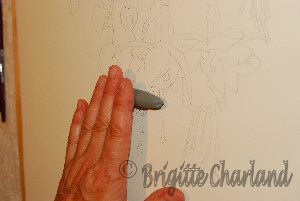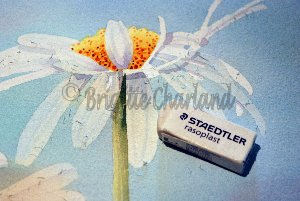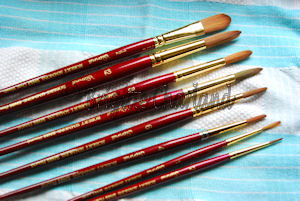 |
|
|
|
|
|
Tricks n tips
| from the watercolorist Brigitte Charland. |
|

DID YOU KNOW? it is preferable to use distilled pure water to keep in a spray bottle to keep your palette humid? Tap water is alcaline and contains alcalino-earthy metals that form white oxydes ans chlorine salts that attack the pigment. You greatly reduce the chance of having mildew or black spots on your colors. If that happens, remove a thin layer of the bad pigment and spray the surface with a mixture of pure water and a few drops of javel. After a few minutes, bloth that liquid with the tip of a tissu. Sray again with very very cold pure water: water on the edge of freezing. Keep your spray bottle in the frige in the Summer, to minimize the risks of mildew.
DID YOU KNOW? that the brush soap in the little beige round box (photo below) is the best thing to kleen your palette's mixing areas? Wash frequently your brushes with it to remove residus that only water can't. Always let your brushes dry flat on a towel or paper.
DID YOU KNOW? that brushes that never stop can build mildew? one of my favorite did; I washed it many times with the brushsoap, and some arsher soaps, and it was still there so I tried an other thing; I let soak for a few minutes my brush in mild water, about 1/4 cup (125 ml) and about a dozen drops of Javex, miracle! all the black spots went away and my brush is very well and escaped a sure death!
DID YOU KNOW? that you should not let your company animals go close to your palette? they smell good but are toxic.
DID YOU KNOW? that before handling watercolor paper you should wash all creams or oils from your hands? they could leave greesy marks on the paper and color would not stick to it.
|
|
|
|
DID YOU KNOW it is very important to oxygenate your pigments once or twice a year? You clean the surface, then sray purified water on top, and with a small spatula or knife, mix the dried pigment on the rim with the creamy one.
Do the same anytime you add fresh pigment.
Make sure when you squeeze out new paint from a tube, to press from the bottom and bring the pigment flush to the rim before putting back the cap. Do not let air breath in the tube. You will keep your tubes in "like new" conditions.
Don't mix together two kinds of pigment even if they have the same name of color. Always keep your empty tubes to bring them to an eco-centre.
____________________
|
|
|
|

I am left-handed so my palette is on my left side. My water cups are just over it and my brushes close to my paper. Every thing has to be at your left or right if you are right-handed. That is because you should not have to criss-cross from one side to another to get color. I frequently spray my palette in a day's work to keep the colors glossy with humidity. When I had pigment to a colour bin, I mix the new one with the old; it rejuvinates it with moisture and oxygen.
I have two cups of water; one to rinse and the other I try to keep clean to make mixtures or to kleen-up quickly. I roll some paper towel around a roll of hygene paper to clean my brush in between mixing. I put my watercolor board on an old beach towel so I can bloth my brush anywhere on it. I write the name of the colour on the side of the palette with a Staedtler Lumocolor permanent fine ink, it can still be eraseable with alcool if you make an error.
_____________________
|
|
|
| clean-up of brushes and palette |
|
|
|
It is highly recommended to give a good clean-up of your brushes and palette before you head-off to the garden. You should do this at least 2 times a year.
Click on the "good clean-up" expression to access to all the instructions; tranlation soon.
|
|
|
|

I love to use PÉBEO's frisquet because it is elastic and neutral colored gray. It allows me great liberty to paint wet-in-wet when I know my whites are safe. Follow carefully these next steps and you will never have bad surprises with frisquet.
You can use any of your good brushes to apply frisquet if you prepare it this way; wet toroughly, then lather it in an oil-free soap before you apply the frisquet. This will protect your brush, give you more time to apply it and will be a breeze to wash-off in cold water. Make sure the lather is colour free to avoid staining the frisquet.
If ever you have frisquet stuck to your brush, quickly soak it in lighter fluid and remove with a tissu.
Also remove with a damp brush any dryed-up color on the frisquet. Bloth with a tissu, dry again before removing.
Always apply frisquet on a very dry paper and remove from a very dry paper. If you touch your paper and it is cool, it is not very dry. Use an hair dryer to make sure the paper is dry before removing the frisquet. If you remove the frisquet from a damp paper, a thin coat of paper will tear away and you will be left with a fuzzy textured paper. Do not let dry in the sun.
_____________________
|
|
|
|

I stapple my paper when it has been soaking in cold water for about 10 minutes. I am sure that it is soaked and ready to let me work wet-on-wet for a long time. If you prefer weting your paper with a brush, you have to start by the back and then wet the right side of your work. You have to apply water many times to be sure it has absorbed enough water to stay wet for a while. You can apply your first wash and then stapple at 1/4 inch (1 cm) from the border and at every 2 inches (8 cm).
This gives me the liberty to paint the way I love to, to wet and dry many times without being bothered by buckling paper.
When you have finished painting, always bloth all excess wather around the paper and especially at every stapple. If wather accumulates there, it will probably be sucked-up by the paper drying faster and create an ugly "blister". Dry with a dryer until that danger is eliminated.
____________________
|
|
|
|

To unstapple my work, I use a special instrument for that but I slide it under the stapple and paper. It prevents the risk of sliding and tearing your work. Always wait to remove stapples or tape until your paper is very dry.
|
|
|
|

It's called bread meat, it not but it feels like you rolled a slice of the white of the bread. It is an eraser specially formulated to remove pencil without scrubbing. You use that king of eraser right at the begining of your work, when your paper has not been wet and dried yet. At that stage, the paper is very fragile, and regular erasers make marks on the surface and shows in your work.
|
|
|
|

When you have finished painting and dried, you can erase with an eraser and it won't hurt your paper.
|
|
|
|

Here is the brand of pinceaux I use and recommand to anyone. It is the Sienna series SN85 Round, from Robert Simmons. The different sizes are 12, 8 (2), 6, 4, 2, a rigger 1, and a liner 2, and cat's tongue 1/2 for softening.
These brushes are made from synthetic material (hair) that is very souple. They are meticulously blended to create a holding ballon and a very precise point. What I love about these brushes is that they automatically and instantly take back their original shape at every stroke. You do not have to re-shape it by hand or by blothing it like a natural hair brush. And so much less expensive.
The reason for different sizes is to have different quantities of liquid-holding. The 8 makes a small point like the 4 but holds too much water for the small area to paint that the requires a 4. The rigger is very long to hold a lot of water to permit you to make a very long but equal line.
You have to ALWAYS wt the brush before picking-up paint so the brush will store clean water near the ferule, preventing paint to get in that area. Always wash in cold water, bloth and let your brushes flat to dry. If you dry them standing up, the humidity (and maybe color) will go down the ferule and will dry there. It also dilutes the glue holding the hair and will make the handle crack and peel an shorten its lifetime. If you ever get mildew in your brushes, wash it with antibacterial soap and hot water.
_____________________
|
|
|
|

Here are the flat brushes I use. They are made by heinz Jordan, HJ 920 wash series, also made of synthetic material. A good quality flat brush holds a lot of paint, has absolutely the same hair lenght and makes a point fine like a pencil line. The different sizes I am showing you are the 3 inches, the 2", the 1 1/2", the 1" each and the 3/4" with clear handle.
The different sizes are for the different sizes of paper you wish to paint.
____________________
|
|
|
| to carry your brushes around |
|

If you have to carry your brushes around, you need a carry-all who will protect them. Avoid those made with materials that are not soft or absorbant. It is very important that the humidity in pulled away by the carry-all. Brushes should not move up and down or touch each other.
It is very easy to make such a carry-all; take some soft, absorbant fabric, then sew some seperations between them, keep fabric to flip back onto the brushes, then roll and attach with a bowtie.
____________________
|
|
|
|
|
Now some advice about Framing your artwork. The traditional frame for watercolors contains a mat surrounding your work, a mat at the back, glass and frame. I would like to explain the different qualities of mats, their usefullness or damage.
You have to demand a completely acid-free mat; the top sheet, the back sheet and the middle thickness of the mat. You will be sure, then that the mat, when affected by ultra-violet rays will not alter the colors in your artwork. You will also make sure that the mat itself will stay very white all the way through.
Quality framers use Bainbridge or Crescent mats because they are made of mostly cotton (like watercolor paper) and not wood fibers. Ask for an acid-free paper covering your work in the back if you are not using an acid-free backing. Your best choice would be to ask for a Foam-core acid-free backing.
The tape holding your artwork to the mat should also be acid-free.
The GLASS is also varied in quality. The glazed anti-reflection glass is NOT acid-free, therefore no good for protecting your work. The ordinary glass is best. But if you want top quality, archival quality glass, you ask for the Truguard glass made by Truvue. It blocks out 99% of ultra-violet rays from stessing the colors and paper of your artwork.
When cleaning the glass of your frames, put it flat and use a foamy cleaner instead of a liquid one. You must avoid glass cleaner to get into your frame.
____________________
|
|
|
|

DID YOU KNOW the best eco-responsable way to get rid of all those paint tubes is to collect them and then bring them to an ECO-CENTER. Some of those old tubes were made of lead! do you imagine throwing those in the garbage. These days, they are still made of metal but a lot less polluting.
If you do not want to WASTE a lot of paper towel when you clean-up, use old beach towel cut in squares of the size of a place mat. They dry by themselves and you can re-use and re-use.
DID YOU KNOW that paper towels and watercolor paper full of colour go the compost bin? yes they do.
Why not use biodegradable bags for those garbage that really have to go instead of a plastic bag?
Why not prepare a bag tittled "eco-centre", so you will think about it before throwing away, batteries, spray cans, paint tubes or chemical products, fluo-light bulbs and whatever goes there!
____________________
|
|
| |
|
|
|
|
|
|
